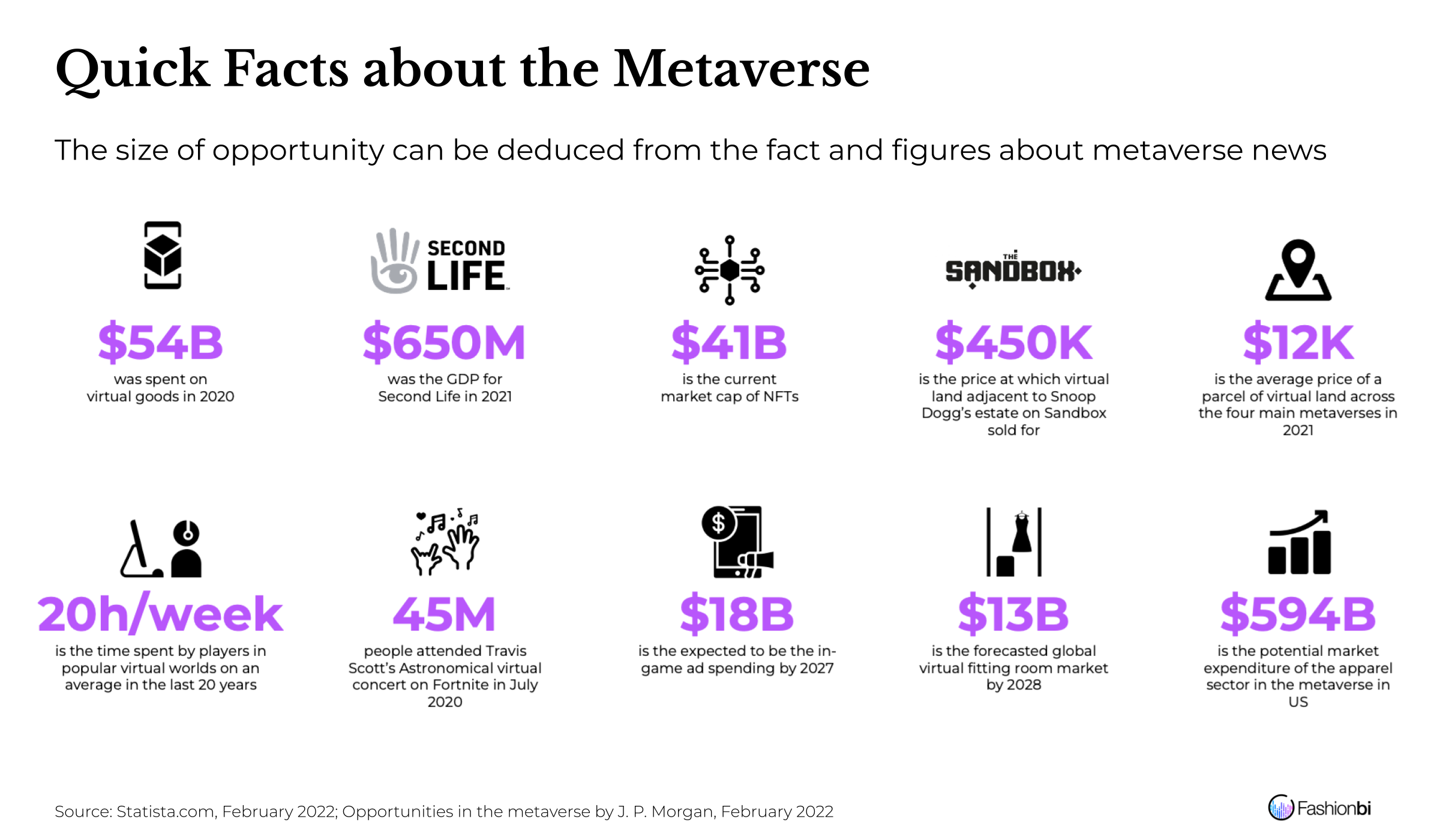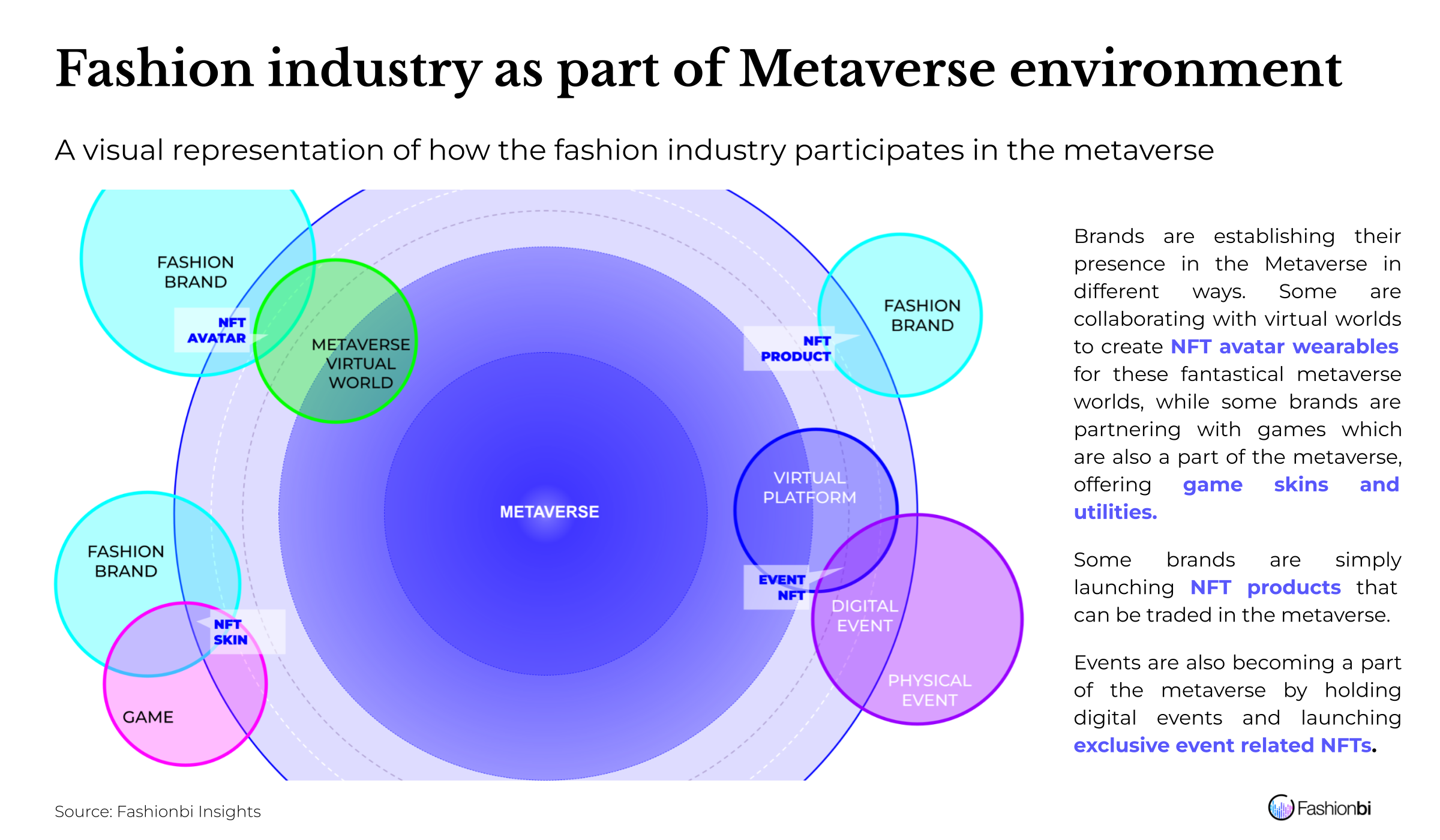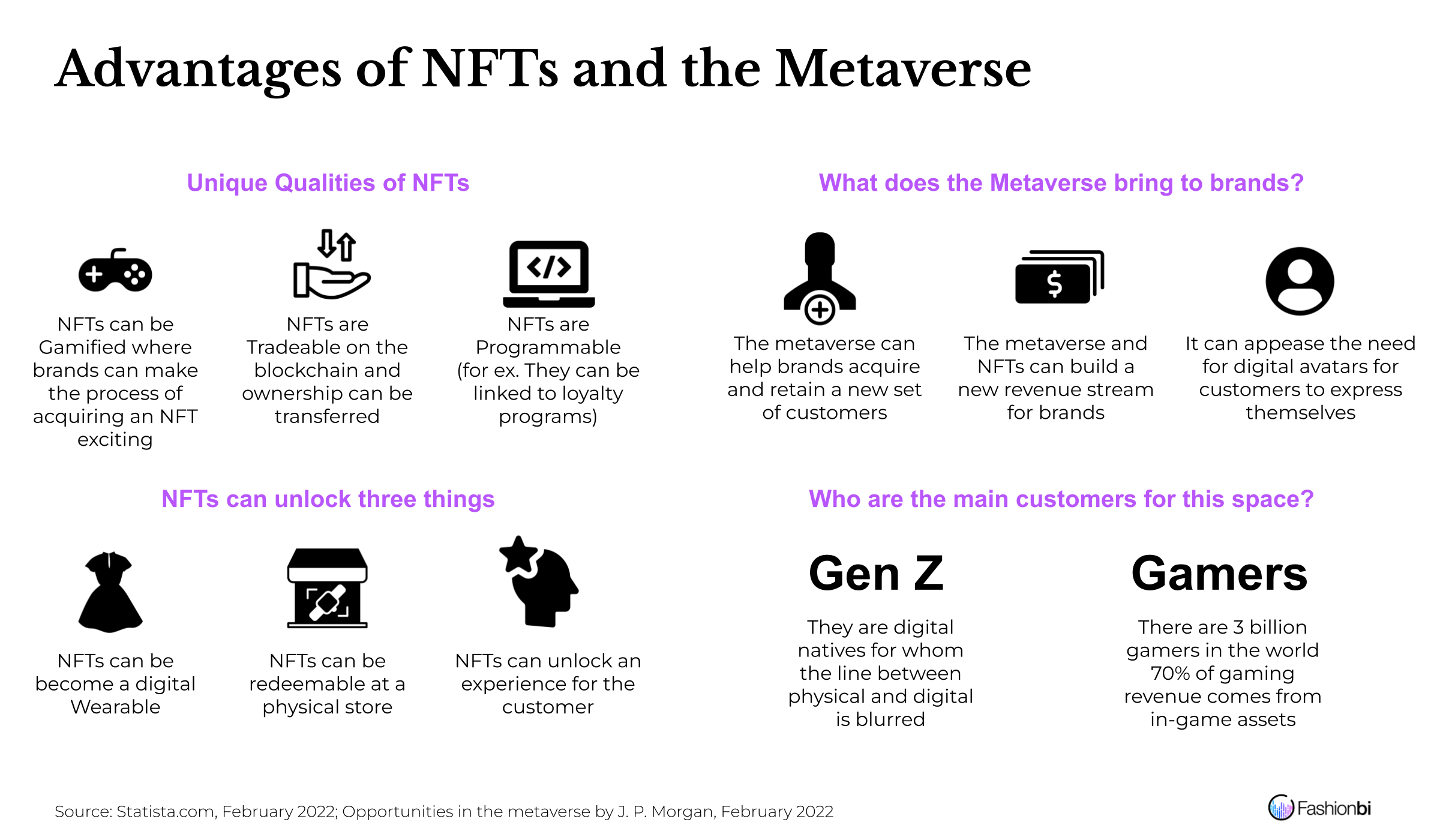Table of contents
What is the Metaverse?
The newest buzzword surrounding fashion and technology is Metaverse. But what does this frequently used term mean?
Metaverse has been a concept much of Silicon Valley has been talking about for a while. However, for the layman, it only became popular when social media giant Facebook rebranded itself as ‘Meta’. In an introductory video, Mark Zuckerberg, founder of Meta (previously Facebook) explained the concept of Metaverse to millions. As he swiped through digital outfits or looked for his virtual avatar, metaverse experts retorted that the company’s attempt at defining the metaverse fell short.
The reason why it is hard to describe the metaverse is because there is no single consensus on its definition. With ever evolving technology, the metaverse is left to technology literates and consumers to simultaneously explore and cultivate. To put it very simply, it’s the version 3.0 of the web, the first two being transmission of information and creating a sharing economy. Many predict that it will be an entirely virtual environment, with people, places, things, all of it being virtual, digitally produced. Access to this virtual reality will be through Virtual Reality (VR) headsets.
Don't miss a single insight, get the full access today
The all-access pass to our entire library and tools
Subscribe
Fashion has jumped on this bandwagon as early adopters of this technology are video gamers, who among other things, like to flaunt their fashion in their virtual worlds. The fashion industry has been taken by this storm with this metaverse trend, where no brand wants to be left behind. By introducing themselves in the virtual world, fashion brands have made themselves relevant again, at the brink of cutting edge technology. There’s no surprise that the latest report by Citi concludes that the metaverse market may be worth 8-13 trillion dollars by 2030, with 5 billion people participating in it.
How Brands are embracing the Metaverse
- Digital Artworks: Brands are collaborating with artists and metaverse creators to launch Digital Artworks, often auctioning them to the highest bidder.
- Virtual Products: Virtual Products which can be worn or used by users’ digital avatars are being created for specific metaverse worlds.
- 3D Products: 3D Products are another version of virtual products, but are digital replicas of physical products by the brand, which can be worn by avatars or kept as collectibles.
- Game Avatars: Game Avatars or skins are entire looks or physical appearance, along with powers and attributes launched by brands for popular virtual games.
- Digital Events: Brands are partnering with metaverse worlds to host Digital Events such as fashion shows, arcades and exhibitions which give users an immersive virtual reality experience.

What is an NFT?
NFT stands for Non-fungible token. Non-fungible means that only one of its kind exists. It cannot be duplicated or exchanged for one or many of the same kind. NFTs exist in the blockchain ecosystem, similar to cryptocurrencies. However, unlike cryptocurrencies, which work like physical money, NFTs cannot be multiple of the same. The most popular blockchain to have NFTs is Ethereum blockchain (however, many other blockchains have introduced NFTs too). What makes an NFT different from an ETH coin (similar to bitcoin) is that they can store extra information.
So what can an NFT be? An NFT can be anything produced or stored digitally. It can be art, music, software, and even virtual assets. There can be digital iterations of fashion objects (like clothing, shoes, bags etc) created as NFTs. Which is exactly what fashion brands are doing currently.
Question is, what is the use of these NFTs? Experts predict that very soon, we will all be communicating and socializing in a virtual reality, with our virtual avatars, and a big part of portraying an avatar is its appearance. Fashion brands have already introduced NFTs for early adopters of this concept - video gamers.
Owning an NFT gives you exclusive ownership to that asset. Which means that in the future virtual world, many may have copies of your NFT, but only you will have the original piece. And you never know what the value of that NFT would be in the future.

Popular Virtual Worlds
The Sandbox
The Sandbox is a virtual Metaverse where players can play, build, own, and monetize their virtual experiences. The Sandbox is a community-driven platform where creators can monetize voxel ASSETS and gaming experiences on the blockchain. SAND is the utility token used throughout The Sandbox ecosystem as the basis for transactions and interactions. It is an ERC-20 utility token built on the Ethereum blockchain. There is a finite supply of 3,000,000,000 SAND.
Decentraland
Decentraland is a decentralized virtual reality platform powered by the Ethereum blockchain. Within the Decentraland platform, users can create, experience, and monetize their content and applications. The finite, traversable, 3D virtual space within Decentraland is called LAND, a non-fungible digital asset maintained in an Ethereum smart contract. Land is called ‘parcels’ and can be bought using MANA, the cryptocurrency used in the world.
Cryptovoxels
Cryptovoxels is a virtual world and metaverse, powered by the Ethereum blockchain. Players can buy land and build stores and art galleries. Editing tools, avatars and text chat are built in. The world consists of a city called Origin City, which has streets that are owned by The Corporation, and parcels that are owned by individual people. If you have an ethereum wallet, you can buy a parcel. Cryptovoxels is compatible with the Oculus Quest, Oculus Rift and HTC Vive.
Somnium Space
Somnium Space is a virtual reality world. It is an Open, Social, Virtual Reality world. A world with its own economy and its own currency. A VR world with its own Marketplace, Games, Social experiences and Virtual Land ownership. A VR world which is fully interconnected and seamless. Fully accessible from any device: PC & VR clients for user's Desktop or an immersive VR experience on mobile devices. Somnium Space is primarily a VR experience. 2D mode is made mainly for exploration purposes.
Roblox
Roblox is an online game platform and game creation system developed by Roblox Corporation. It allows users to program games and play games created by other users. It proclaims to be a 3D platform for online gamers, launched in 2007. It has 64 million players every month, with an estimated total 178 million accounts on the platform. The Roblox Suite allows gamers to create their own game or create another world with friends or ‘virtual explorers’.
Fortnite
Fortnite is a free-to-play battle royale game developed and published by Epic Games. It was released on the Nintendo Switch in June 2018. Players can drop onto the Island and compete to be the last player — or team — standing, hang out with friends to catch a concert or a movie, create a world of their own with their own rules, or Save the World by taking down hordes of monsters with others.
Top Fashion Brands Making Important Investments
Leading fashion and luxury brands are making important investments in the metaverse and NFT space. For instance Nike built Nikeland within Roblox in November 2021. Since then, the brand has seen almost 7 million visitors from 244 different countries at its metaverse store. In December 2021, Nike acquired virtual sneakers and collectibles company RTFKT. RTFK is a leading brand that leverages cutting edge innovation to deliver next generation collectibles that merge culture and gaming. RTFKT is a pioneering and innovative brand that redefines the boundaries of physical and digital value to serve their broad community of creators. RTFKT uses the latest in game engines, NFT, blockchain authentication and augmented reality, combined with manufacturing expertise to create one of a kind sneakers and digital artifacts. RTFKT is known to be creating viral sneaker designs, memes and collectible exclusives.
Luxury conglomerate LVMH has already marked its presence in the virtual world, as its key brand Louis Vuitton partnered with Riot Games to introduce skins in the game League of Legends. The conglomerate has now appointed a virtual ambassador to present its brand innovations at the next edition of the Viva Technology conference in June 2022 in Paris. The avatar is a female with gray blue eyes and short brown and white hair.
Italian brand Diesel has launched its very own virtual platform called D:VERSE platform in March 2022. The platform has unique NFT versions of the brand’s runway clothes, plus physical pieces of sneakers and accessories. The platform has a combination of virtual and physical items. The users who have NFTs from this platform have exclusive access to a Discord channel and D:VERSE-KEY, which grants exclusive rights to discounted NFT pre-sales, raffles, metaverse wearables and more.
Digital Assets in China
As the whole world grew fascinated by NFTs, Chinese customers, who are known for their tech savviness, also jumped at the concept. However, the Chinese government is not very supportive of cryptocurrency. So, NFTs are referred to as ‘digital collectibles’ in the country. Despite the views of the government on crypto transactions, the growing interest of Chinese customers in NFTs has resulted in Chinese tech giants to invest in this technology.
In June 2021, Alibaba banned the resale of NFTs on its second-hand market (Xianyu) when an NFT was being sold at much higher price than its original price. However, since then, big tech, blockchain startups, art auction houses, and retail brands have begun introducing projects revolving around this space. In June 2021, Alipay launched 8,000 limited-edition NFTs in China, based on two pieces of ancient artwork from the Dunhuang Caves. August 2021, Tencent, China’s largest social media and gaming company, developed an NFT purchase and collection trading platform (Huanhe). In January 2022, Alipay launched NFT-powered digital collectibles inspired by the 12 Chinese zodiacs. Alipay has also introduced ‘Topnod’, a mini-program dedicated to digital collectibles and embedded in Alibaba’s online payment app.
In January 2022, Xiaohongshu, also known as Little Red Book, launched its own digital collection platform named ‘Step Into R-Space’. Within a couple of months, the platform started showcasing digital wearables of their users through virtual runway shows. In March 2022 it was announced that Weibo would partner with NFT-powered digital collectible platform TopHolder to upgrade its system with the new technology.
Key Takeaways
- Metaverse and NFTs have become the new buzzwords in the fashion and luxury industry as industry leaders expect a complete overhaul of the system with the adoption of Web3.
- Virtual Reality was already gaining popularity among users, especially receiving a boost after the COVID-19 pandemic hit, which led to fueling of digital formats. Many fashion brands saw great potential in VR projects.
- After Facebook and Instagram parent company renamed itself Meta, the idea of metaverse has gained a lot of momentum. Luxury brands have been at the forefront of early adoption of this technology.
- Metaverse in the simplest form can be described as a virtual reality world on blockchain platforms which can be accessed through VR headsets. NFTs or non-fungible tokens are digital assets on the blockchain. NFTs can be in any format, video, audio, images, etc.
- Fashion brands are entering the metaverse by launching NFTs, often in collaboration with other metaverse entities or well-known metaverse creators.
- Some of the popular metaverse platforms are The Sandbox, Decentraland, Cryptovoxels, Somnium Space, Roblox, Fortnite and Zepeto. Many fashion brands have launched special collections in the form of NFTs on these platforms, which have sold for thousands of dollars.
- Brands have launched NFT avatars, game skins, digital NFT versions of their physical products, NFT artworks and collectibles.